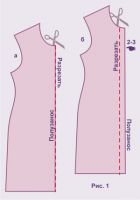 This easy-to-implement idea is suitable for reworking a sheath dress, as well as other symmetrical styles.
This easy-to-implement idea is suitable for reworking a sheath dress, as well as other symmetrical styles.
By inserting one strip 5 cm wide, we, taking into account all allowances, increase the volume of the dress by 1 cm.
A strip of 6 cm - respectively by 2 cm, a strip of 7 cm - by 3 cm.
If more magnification is needed, 2 strips are required.
There is another very important point that I would like to dwell on.
The vast majority of people recover conditionally forward, therefore, to increase the product, it is often enough to increase only the shelf.
A uniform increase in the shelf and backrest is also possible.
But, at the same time, the width of the neck should increase by about 1/4 of the increase in the shelf, and the width of the sprout by about 1/3. Of course, it is better to clarify this on the fitting.
In addition to the dress itself, which has become cramped, you will need a companion fabric.
Product preparation.
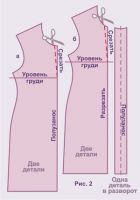 Open the neckline or collar, open the bottom.
Open the neckline or collar, open the bottom.
After that, the product must be steamed.
Before proceeding with cutting, the dress must be folded, combining the side and shoulder seams, darts and reliefs (if any), bottom and halves of the neck.
Combined seams, cuts and elements should be chopped off with tailor's pins.
In the dress prepared in this way, mark the half-skid (Fig. 1).
If you chose the option with one strip, cut the shelf along the half-slide (Fig. 1 a).
In the variant with two stripes, lay a line for marking along the half-slide and, departing from it 2–3 cm, make cuts on both shelves (Fig. 1 b).
 Please note that it is better to perform two cuts in turn - first one, then the other, retreating the required distance from the marked half-skid.
Please note that it is better to perform two cuts in turn - first one, then the other, retreating the required distance from the marked half-skid.
This is necessary so as not to accidentally break the symmetry.
The result you see in Fig. 2 a, b.
And we came to the point of proportionally reducing the neck.
To do this, we need the level of the chest.
To determine, you can use your own measure of Chest Height.
So, the solution of the tuck from the neck is
the width of the finished insert minus 1/3 of the same finished insert
 Of course, this is an approximate formula.
Of course, this is an approximate formula.
Therefore, we only mark the tuck, given that its top should be 2-3 cm higher than the level of the chest.
We will cut off the excess after fitting.
Cutting the insert strip is not difficult (Fig. 3).
I would like to add that the insert can be supplemented with stitched wedges.
Dresses - patterns
|
||||||||||||
Sewn because one-piece will go much more fabric.
Further actions are clear: fitting, attaching the insert (s), ironing the seams, processing the neck and bottom.
For example, having marked the waist level (Fig. 4), insert a strip instead of a belt (on the left in Fig. 5) or lengthen the skirt with two inserts of different widths (on the right in Fig. 5).
I would like to warn beginner couturiers that transverse stripes can greatly distort or visually correct the proportions of the figure.
To avoid miscalculations, it is better to outline the waist on the fitting.
For customers of the brachymorphic type or owners of a “heavy” top, the waist can be slightly overestimated.
Accordingly, for dolichomorphic girls and ladies, especially those with a “small” chest, the waist can be slightly lowered or a strip placed on the hips.
In the latter case, the strip on the hips will imitate the bottom of a blouse or jacket.
As for the stripes at the bottom of the dress (Fig. 5 on the right), it is difficult to give an exact recipe for use, but in any case they will not suit short ladies with dense or overweight figures.

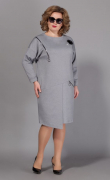









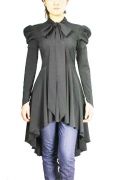




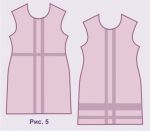

 Join my community on Viber...
Join my community on Viber...











